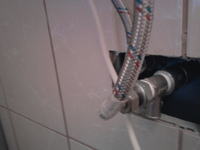It is not strange. The reason for this is the difference and the absence of a pressure difference. The pressure difference causes the hot water to flow towards the cold one, and the pressure balance does not flow, so when we do not take water, the outflow is so-so - colder than the water in the boiler. A warm hose or cold water inlet pipe on both sides of the safety valve is a symptom of a bad safety valve as well as a rumble in the absence of water consumption, because hot water increases its volume in the boiler and the pressure returns hot water through the safety valve to the cold pipe where it is the pressure is much lower and the safety valve should not allow it. On the other hand, the hot water hose will be colder when we do not take water, because the pressure in it is the same as in the boiler all the time because there are no check valves, so there is no such flow as in the direction of the cold water supply, which has a pressure much lower than hot water, hence there is more space for hot water returned to the cold supply, especially during the day, it is noticed when the pressure in the line is lower at all due to water consumption by many users in the city, for example, and less noticeable in a private house ... Touching the water supply is how old non-holding valves are diagnosed, especially in the morning or when the water has not been taken from the tap for a long time - as it turns out, also new valves do not hold ... Therefore, you see, the safety valve must fulfill two roles, not to allow reverse flow aw in case of a simultaneous failure of the thermostat and the temperature regulator, drop some hot water sideways so that the boiler does not become a bomb, i.e. reduce the pressure therefore it must be installed right under the boiler so that the pressure does not increase in the hose, which are not long-lasting! Also once in my life I saw the effects of a boiler bursting - half of the house blew up ... Therefore, you must not give up the thermostat under the boiler and the temperature regulator, I hope that your new boiler has these two independent electrical protections in working order ...




